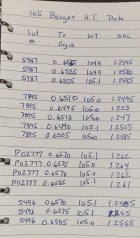GetReal
Silver $$ Contributor
So I got a pretty good 6mm load, but gonna hafta switch lots. So I gathered a buncha data. I'm thinking the OAL factor is least important, then not sure of the order btwn bullet weight and / or length to ogive.
I think length to ogive *may* have about a 5/1000 window that may allow some wiggle room without opening groups up .... and bullet weight seems important. I think. Ironically, its the most consistent metric of these Berger bullets.
Also, I'm guessing if I move toa bullet with 4/1000 shorter bullet length....say 0.6555 to 0.6510, then I adjust my seating die 0.004 to get the same base to ogive ...theorettically.
End of the day, what happens at the range, on the target matters most.
But what conclusions would you draw from these different lot #'s ?
Mostly, how do you go about changing Lot #'s?

I think length to ogive *may* have about a 5/1000 window that may allow some wiggle room without opening groups up .... and bullet weight seems important. I think. Ironically, its the most consistent metric of these Berger bullets.
Also, I'm guessing if I move toa bullet with 4/1000 shorter bullet length....say 0.6555 to 0.6510, then I adjust my seating die 0.004 to get the same base to ogive ...theorettically.
End of the day, what happens at the range, on the target matters most.
But what conclusions would you draw from these different lot #'s ?
Mostly, how do you go about changing Lot #'s?

Last edited:










